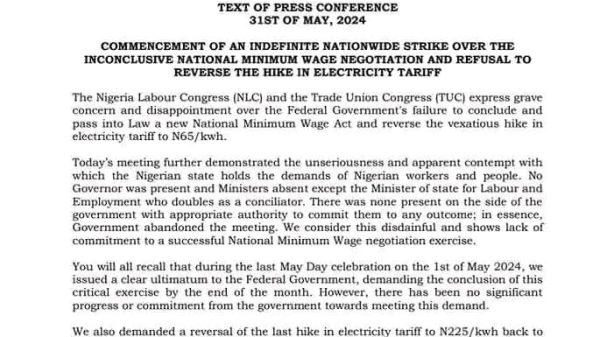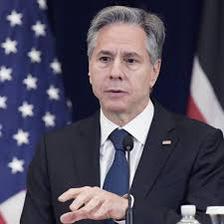Agric Sector: Going Back To The Drawing Board
By Ussiju Medaner
Last week I began a series that understudies the primary democratic needs of Nigeria and Nigerians to get the best out of the new Administration of President Bola Ahmed Tinubu. We cannot continue with the narrative and rhetoric of business as usual; appointing ministers and heads of agencies and parastatals just for the sake of filling positions and paying back political associates. The renewed hope agenda is only realisable when appointed ministers and heads of government agencies set agendas that meet the yearnings of developmental and growth demands of the people and implement projects and policies that deliver results to Nigerians – preferably as quickly as possible.
Nigeria does not lack the resources needed to develop from within; from natural to human resources, the country stands out with abundant endowments that beg for effective and efficient utilisations. The objective of this series is to set agendas in line with available and accessible resources and the deliverables that are desirable for ministries and agencies of government.
The recommendations that are contained in the submission and all those that will subsequently be released are products of painstaking research work as per the needs of ministries, available resources and possible developmental pathways. Hopefully, they will be acquired as blueprints for policy formulations by affected ministries.
This week, I will take on the ministry of agriculture and agencies and parastatals under the ministry. The stream of services being tackled by the ministry is very critical to national survival and development above every other ministry, hence the ministry must get it right to deliver its mandate of national food security and seamless flow of agricultural-based raw materials for industrial development.
We must recognise that the first need of a nation before the call for development is the capacity to feed itself. This is agricultural development. When a nation sufficiently builds the capacity to self-feed itself, it would literally move to the next stage of development which is transferring its agricultural surplus to industrial raw materials.
The elements of national industrialisation hinge first on agricultural development and sufficiency, from where processing industries spring up to process excess crops, livestock and allied primary products. A hungry nation cannot be a productive nation. For all developed nations, national development hinges on two critical supports historically: agricultural development and industrialisation, especially technology/steel development. Aside from guaranteeing food security for the nation, agricultural sufficiency directly translates to industrial development as inputs to most producing factories are sourced from agriculture.
If we are going to get it right and lay the real foundation for the total development of Nigeria, we must begin by getting it right in the agricultural sector. When we take advantage of our resources and produce food for the teeming population of the country, we will be on the right trajectory to the greater future that we dream of. That is one of the many things the immediate past administration of President Muhammadu Buhari gets right by increasing the local rice production capacity and sufficiency for the country.
What Nigeria needs now as a strategic consideration is very simple to articulate: a deliberate set of actions to return the country to the pre-petroleum era, when agriculture was well entrenched as the mainstay of the nation and was responsible for the bulk of the national annual GDP, providing more than enough locally to feed Nigerians and generating exports and raw materials for many local and foreign industries. That was the period when the capacity of agriculture to generate and provide employment was fully harnessed and was employing the bulk of Nigerians at various levels. That point in time when the regions were developing largely monolithically on the strength of agricultural produce and incomes. The cocoa in the West, the oil palm in the South the groundnut pyramids of the North and the immense contribution to the then economic stability of the country and its people would readily come to mind.
Early in the Nigerian post-independence era, the national leadership was determined to accelerate the pace of development of regional and national economic growth via both direct and indirect investment in agriculture. With huge foreign exchange earnings and government revenues, reliance on agriculture made the development of major export crops more rapid. Infant factories sprang up in every corner of the country; and employment opportunities abounded, while incidents of rural-urban migration were at their minimum.
Unfortunately, the sector began a decline in the 1970s with surpassing inflows of revenues from crude oil and subsequent deliberate and sustained neglect of the sector by subsequent governments, constituting a decline in the GDP contribution of agriculture from 65% in the 1960s to 34% in 1974 and less than 8% in 2005, and till now. That was what we lost with the discovery of crude oil and the commencement of commercial production of the same in 1965. We abandoned the prospect of agriculture and all the attendant additions to national food security, stability, industrialisation and employment generation.*
Managing the sector alongside the then-emerging petroleum industry would have meant effective diversification of the national economy, which would have resulted in a significant rise in total GDP with the attendant increased employment opportunities and a more balanced and stable economic development. Instead, we chose to neglect the ever-abundant prospect of the fertile lands that support all crops all over the country; the all-season rivers and coastline bordering the Atlantic Ocean and the livestock industry to the detriment of the national economy and development. We removed attention from the growth-inspiring sector; farming and other agricultural practices that could ameliorate our unemployment crisis, reduce the cost of food items, raise the national GDP and catalyze the springing up of factories within the agriculture industry, were left in a rudimentary state and with almost zero governmental input for a long time.
The neglect of the sector began the paralysis of the industrial sector in Nigeria as raw materials that came from the sector dwindled and were no longer forthcoming. As a result of the neglect and the consequent recession and austerity, there arose a total declining change in the industrial sector performance leading to the contraction of the economy, the decline in disposable incomes and a substantial drop in domestic demand for industrial goods and then mass retrenchment of the industrial labour force.
*Business opportunities for commercial produce such as cocoa, palm oil, rubber, and groundnut abound in the country. For instance, up till the late 1960s, Nigeria was the heartbeat of global palm oil production producing close to 43% of all palm oil consumed worldwide but today we produce only 2 per cent of total global markets. This was a market that as of today would have been earning the country about 20 billion dollars annually. While we lost out on the oil palm prospect, we simultaneously also lost out on others. The West was booming with cocoa plantations and a thriving industry. The famous Cocoa House in Ibadan was the icing on the cake. At that time, Nigeria and a few other African countries were responsible for about 71% of global cocoa production but that figure has dropped significantly with Nigeria contributing to the dismal decline. Cotton plantations and groundnut pyramids have also become stories and lessons for our children in schools.*
Now, what must be done to return to the enviable days of the past? It is definitely not going to be as easy as it may theoretically appear, but it is a task that must be done by all related ministries for the sake of Nigeria’s stability and the wellness of the people who have become increasingly battered by the recent and ongoing economic hardship including difficulties of accessing staples by the teeming poor.
Setting objectives for the agriculture ministry would be high stake under the current dispensation; including but not limited to getting a sizeable population of Nigerians into agriculture and agriculture-related practices, making arable lands and inputs available and accessible, partnering and coordinating players in the sector, creating regulated markets for agriculture produce, guaranteeing spread of storage facilities across the country, and providing sustained security for farmers across the country.
The first thing that the Ministry of Agriculture must have to do is to return a substantial population of Nigeria back to agricultural practices – both food and cash crop farming and animal rearing. Where do we get this needed population of readily available and preferably trained population to venture the country into mass agricultural practices? There are very few ways to solve this challenge; while attention must be drawn to the existing farming population across the country, the other and perhaps the most readily accessible would be for the Ministry of Agriculture to partner with NYSC to design a cooperative program that will engage all serving corps members of agricultural backgrounds into a pool of farmers.
These corps members are to form groups of farmers’ caucus, each group with a choice of crop or crops to farm, as well as livestock to rear. There would be a partnership agreement and a profit-sharing agreement between the government and the units. While the government would be responsible for making land available for the groups, and supplying them with basic inputs including starting capital, the team members would have the responsibility of planning and managing the farms.
While the units will manage the farms, they would be obliged to pay off, in instalments, the cost of inputs, lands and starting capital as well as an agreed small portion of the profit as the government takes in the venture. The balance of the profit would be shared by participating partners in each unit.
For the non-NYSC farming population, the ministry should do the following; firstly, the state ministries of agriculture should be engaged to collate a comprehensive register of large-scale farmers across the country to enable easy access and communication.
Secondly, the issue of capital facilities should be elaborately discussed and a sustainable agricultural financing policy produced. The framework should highlight the sources of funds, the modes of access, the monitoring procedures, the minimal interest schedule, the repayment pattern, etc. The era of agriculture funds going to non-players in the sector must be addressed to the core and totally eradicated.
The ministry then must set up a working framework to set up agricultural produce marketing boards in each of the 36 states of the federation. The board will be responsible for, among several other things, the market price control and moderation that would favour both the farmers and the buying population. This is necessary to protect the farmers and make the venture economically viable enough for the farmers to continue going to the farms, as well as protect the population.
Then, the issue of storage facilities, in the form of standardised silos across the states is another consideration. As part of measures to protect the farmers through price control, the country must develop a capacity to control the quantity available per time through storage.
Another very critical element of the agenda of the ministry must be the strategic relationship with security outfits to guarantee the safety of farmers from all forms of attacks and destruction of farms, as well as kidnappings. The Ministry of Agriculture must coordinate with the military, the police and the civil defence to protect specific farm facilities across the country. This would include addressing the non-relenting incidences of cow grazing on farmlands and the destruction of farms by the same. The Ministry of Agriculture must liaise with the office of the National Security Adviser, to end the uncontrolled grazing of cows on cultivated farmlands.
One other projected plan of the ministry must be to liaise with interested individuals, organisations, and the manufacturing association to set up receiving cottage industries for locally produced raw materials from the farms. This should also form part of the interactions between the ministry and the organised NYSC farmers groups.
Altogether, we must recognise that direct and indirect investment in agriculture of the magnitude expressed in this piece would benefit the country in more than one way. We will be looking at food stability, accessibility and affordable cost in a very short time in the future. We would be seeing the creation of mass employment opportunities across the entire value chain of the agricultural industry and all the attendant benefits to the country and the people of Nigeria; and finally, a robust contribution to the national GDP, of the order of the early independence years if not more.
GOD BLESS THE FEDERAL REPUBLIC NIGERIA!














































